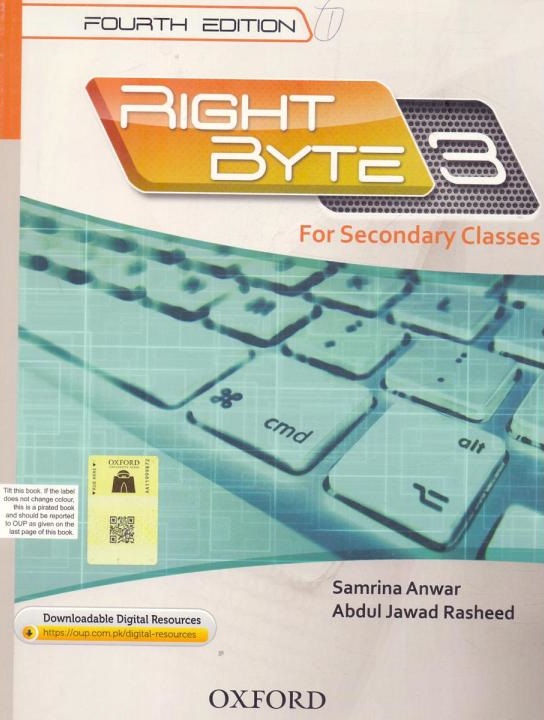Chapter 7 – Data Verification and Validation
Solved Exercise of 8th Class Chapter 7-Computer
8th Class Chapter 7-Computer of the Oxford Right Byte Series computer studies introduces key concepts like data integrity, common types of errors, data verification, data validation, and validation checks. This chapter is fundamental in building a solid understanding of how computer systems maintain accuracy and ensure reliable data processing. In this blog, we will walk through the solved exercises for this chapter, giving you a clear understanding of these crucial topics.
Overview of Oxford Right Byte Series
The Oxford Right Byte Series is a widely recognized textbook series for teaching computer studies in schools. For 8th class students, Chapter 7 in this series focuses on important concepts related to computers, equipping students with essential knowledge in the digital world. If you’re studying for exams or need help with your assignments, this post will walk you through the solved exercises for 8th Class, Chapter 7, providing you with clear and concise answers to strengthen your understanding.
Solved Exercise of 8th Class Chapter 7
A. Fill in the blanks.
1. Data that is complete, accurate, and sensible has ____________.
2. Typing WORDL instead of WORLD is a _____________ error.
3. We can spot________ in data by data verification.
4. A_______ check is used to verify dates.
5. Double-entry is a method of data___________.
Answer: 1. integrity 2. transcription 3. errors 4. range 5. verification
More Useful Links for your Study!
B. State whether the following statements are true or false. Rewrite statements to make them true.
1. Incomplete data leads to wrong results. (True)
Incomplete data can lead to inaccurate results.
2. Errors that occur while data travels over a network are called transcription. (False)
Errors that occur while data travels over a network are called transmission errors.
3. It is possible for incorrect data to avoid detection during verification. (True)
It is possible for incorrect data to avoid detection during verification due to limitations in the verification methods used.
4. In the double-entry method, the computer asks data to be entered twice. (True)
In the double-entry method, the computer asks for data to be entered twice to ensure accuracy and consistency.
5. A consistency check can be applied to verify the accuracy of delivery orders. (True)
A consistency check can be applied to verify the accuracy of delivery orders by ensuring that related data fields match.

C. MCQs, Select the correct option for each question.
1. Data has integrity when it is_____________, accurate, and sensible.
a. complete
b. numerous
c. processed
d. outdated
Answer: a
2. At which stage do most errors occur?
a. data entry
b. data capture
c. data processing
d. data counting
Answer: a
3. Which type of errors occur due to faults in the communication line?
a. Programming
b. human
c. transmission
d. random
Answer: c
4. The double-entry method enables a computer to___________data.
a. Validate
b. process
c. sort
d. verify
Answer: d
5. Data validation involves checking whether data lies within a sensible__________
a. range
b. duration
c. list
d. Code
Answer: a
D. Answer the following questions.
1. What is meant by data integrity?
Answer: Data integrity refers is a quality that make data useful and valuable. Data is complete, accurate and lies within a sensible range has integrity. Data that has integrity produces accurate result.
2. How does the double-entry method help a computer to verify data?
Answer: The double-entry method enables a computer to verify data by asking the user to enter the same data twice. The computer than compares the both entries to see if they match, then data is verified. If it doesn’t match data is not verified.
3. What is meant by data validation?
Answer: Data validation is method of checking data that is processed by a computer is complete, accurate and within a sensible range.
More Useful Links for your Study!
4. Describe three types of checks used to validate data.
Answer: Data validation uses several checks to validate data. Three types of checks are describe below:-
1. Alphabetic Check
Alphabetic Check: An alphabetic check is used to make sure that only letters of the alphabet are entered as input for example: the name of person should contain only letters and not numbers.
2. Completeness Check: A completeness check is used to make sure that all the data that needs to be processed is entered, for example: on student’s report card, the marks of all the subjects should be entered. If the marks of ny one subject have been left out, the computer will not process the data.
3. Range Check: A range check is used to make sure that data is entered lies within a sensible range.
5. Choose a sensible maximum value that could be used as a data validation check in the following cases:
a. the ages of students at a secondary school
A sensible maximum age for secondary school students could be 16 to 17 years.
b. the heights of officers at a police station
A sensible maximum height for officers could be 6.6 to 7.0 feet.
c. the weights of members of a swimming club
A sensible maximum weight for members could be 70 to 80 kg
6. Give an example of data on which each of the following validation checks would be carried out:
a. alphabetic check
Example: As in the name of a person or a city
b. numeric check
Example: As in a telephone number (with the exception of special characters such as the hyphen and brackets)
c. consistency check
Example: The manufacturing and expiry dates of products.
d. completeness check
Example: An admission form.
e. table lookup
Example: an order placed at a restaurant.

More Useful Links for your Study!
Note:
Looking for a comprehensive solution to your computer studies exercises? We’ve got you covered! Our solved exercises of 8th Class for Chapter 7 from the Oxford Right Byte Series for students, teachers, schools, and colleges who want to enhance their learning and teaching experience are now available in a convenient PDF format in cheap price.
Please contact us on WhatsApp +92 333 672 2439







